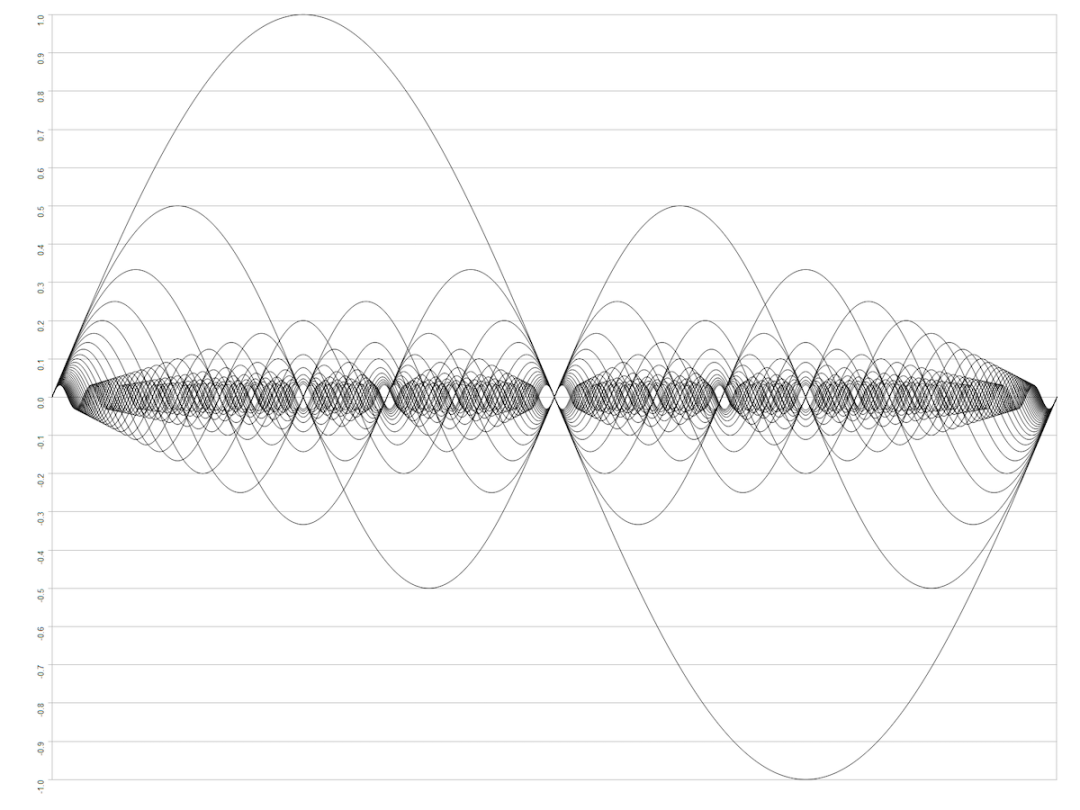The overtone series, also called the harmonic series, naturally occurs due to the way sound waves vibrate. Practically speaking, it helps define an instrument’s timbre.
What Are Overtones in Music?
A fundamental frequency is that of the primary note being played. For example, if you play an A2 on a keyboard, the fundamental frequency is 110 Hz. In the most general sense, overtones constitute any resonant frequency above the fundamental that sounds in tandem with the fundamental.
So when you play A2, you aren’t just hearing 110 Hz by itself. You’re hearing both harmonic and inharmonic multiples of 110 Hz that give the instrument it’s unique sound. However, not all overtones resonate at the same intensity, and many are too quiet to hear at all. This occurrence happens based on the way sound waves work in nature.
How Do They Form?
Sound waves don’t vibrate “perfectly.” These are not simple sine waves we’re dealing with when someone sings, plays a guitar or piano, or blows air into a wind instrument. Instead, the fundamental frequency vibrates with many other frequencies layered in with it. Again, this is a natural phenomenon.
There Are Two Different Types of Overtones
The two kinds of overtones you’ll probably hear referenced are harmonic and inharmonic partials. Harmonic partials are whole number multiples of the fundamental frequency and help us define the overtone series using predictable ratios that do not change regardless of the fundamental. Inharmonic partials are not whole number multiples; instead, you’ll see multiples like 1.2 and other non-whole numbers.
What Is the Overtone Series?
Anyone can figure out the overtone series associated with any given fundamental. We’ll again use A2 (110 Hz) as an example of how the overtone series works.
- Fundamental: A (110 Hz)
- First Overtone: A (220 Hz); one octave above the fundamental, vibrating at a 2:1 ratio. For every one cycle of the fundamental, there are two cycles of the first overtone.
- Second Overtone: E (330 Hz); one octave and a perfect fifth above the fundamental, vibrating at a 3:1 ratio.
- Third Overtone: A (440 Hz); two octaves above the fundamental, vibrating at a 4:1 ratio.
- Fourth Overtone: C# (550 Hz); two octaves and a major third above the fundamental, vibrating at a 5:1 ratio.
- Fifth Overtone: E (660 Hz); two octaves and a perfect fifth above the fundamental, vibrating at a 6:1 ratio
And so on! This is how the overtone series works, and each one of these frequencies is actually part of the fundamental. The fundamental will still be the loudest, but it gets its overall timbre based on all of the other frequencies ringing simultaneously.
What Are Harmonics?
Harmonics are strictly defined as those ideal multiples of the fundamental frequency which comprise the overtone series. The terms overtone and harmonic are often used interchangeably, and you probably wouldn’t be misunderstood if you swapped between the two. However, there is a distinction between them.
Are Harmonics and Overtones the Same Thing?
All harmonics are overtones, but not all overtones are harmonics. To reiterate, harmonics make up the overtone series. They consist of the whole number multiples of the fundamental frequency. Another way to label the overtone series is as follows: 1st harmonic (fundamental), 2nd harmonic (first overtone), 3rd harmonic (second overtone), etc.
“Overtone” is a more general term to describe any resonant frequency higher than the fundamental, including those inharmonic partials (which, in most cases, are too faint to hear anyway).
How Does Understanding the Overtone Series Apply in the Studio?
All of this knowledge is fun to have, but it begs the question of whether there’s any practical application in music production. One of the best ways to apply the overtone series is for chord voicings, whether it’s a solo instrument or ensemble. The general rule of thumb is to space lower notes in the chord at further intervals apart, whereas higher notes in the chord can be spaced closer to each other. The idea is to create a balanced voicing, and that “rule” stems from the overtone series.
Another practical application could be mixing kick drum. Let’s say you have a kick tuned to 60 Hz — that’s its fundamental frequency. You want to get a bit more audible low end punch out of it. A way to do that is to boost 120 Hz, or the first overtone, so you keep the kick “in tune” but get more audible lows out of it.
There’s also the pretty famous example of a barbershop quartet’s “phantom” pitches. A really well-tuned quartet can sound like a larger group, because they actively work towards arrangements that reinforce each other’s parts and actually enhance audible overtones.
It takes a bit of creativity — or perhaps more accurately, scientific and technical thinking — to apply the overtone series to production and mixing. But a basic understanding of how sound/notes/frequencies work may come in handy when you least expect it.
